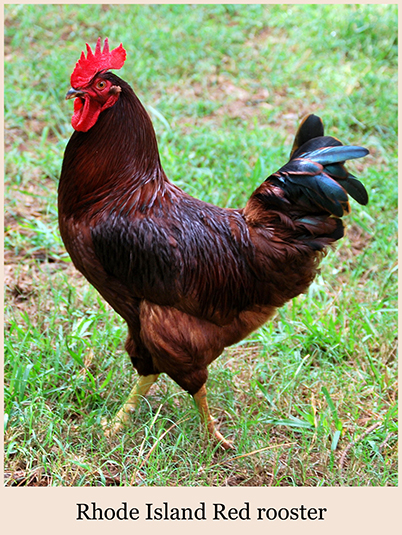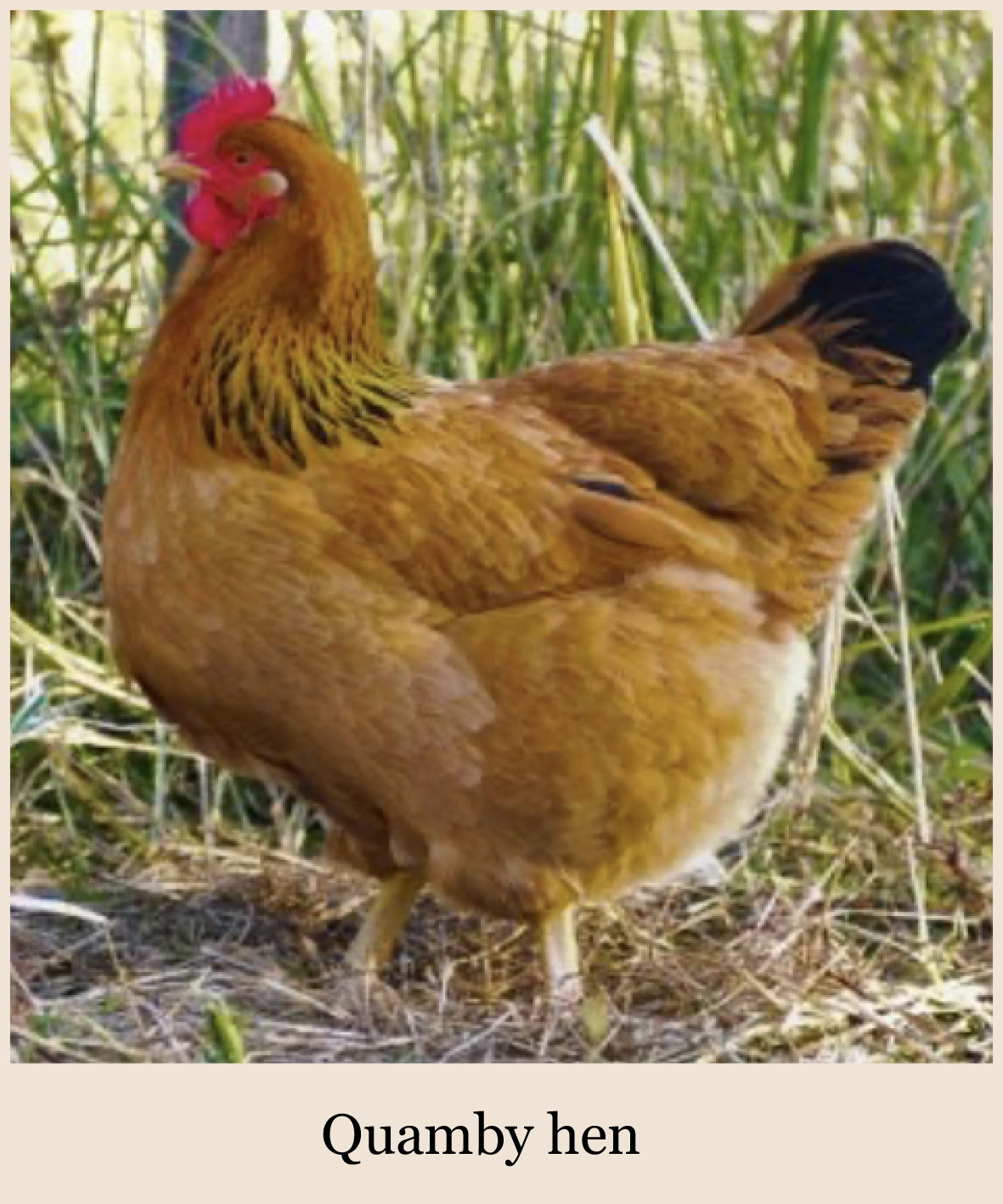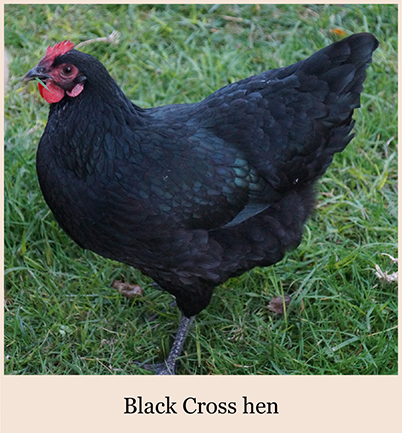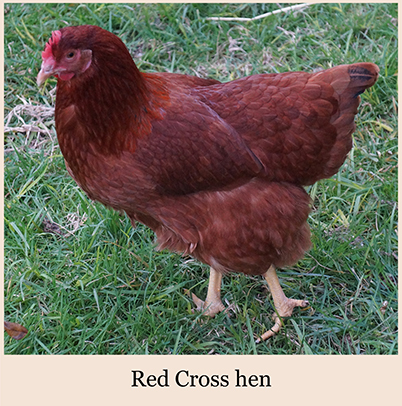
There are basically two kinds of chicken you can buy: breeds, and crossbreeds—also known as hybrids
Breeds
There are numerous breeds of chicken—also called purebreeds, pure lines, inbred lines, lines, strains, etc. because on breeding they conform to type. These have been bred for eggs, meat, looks, or a combination thereof [1-4]. The Leghorn was the most important layer in Australia and remains as such in the USA. It lays a white egg, the American preference—along with white bread. Personally I like the look and personality of the Barred Plymouth Rock (an American breed), Buff Orpington and Light Sussex (two English breeds). However these large dual purpose birds—for eggs and meat—eat a lot of food, poop a lot, and often go broody. The Quamby is a new dual purpose chicken being developed in Tasmania by assimilating the Barnevelder, New Hampshire Red, and Sussex breeds. The popular Australian Langshan lays well, is not particularly broody, is medium-size with a good food-to-egg conversion ratio, and is reputedly a good winter layer (lays well without the need for add-on light). The consensus is that the best laying breeds are the Australorp, Leghorn and Rhode Island Red. However, as with any breed their laying performance will depend on how well the stock has been monitored and selected.
It’s less hassle to buy chickens near or at point-of-lay (~20 weeks), so you don’t have to keep them long before they start laying. Buying them as hatchlings means they must be kept warm with a brooder until they develop feathers, and it’s a long wait before they lay—at least six months. Of course, your kids may really want those cute fluffy hatchlings. If you want a particular breed, you may have no choice but to buy hatchlings or young pullets.
Crossbreeds — commercial colour-sexed browns
Crossbreeding—also called hybridization, is a common strategy for maximizing yields in agriculture, with the crossbred plant/animal being superior in performance to either parent. The performance boost is called heterosis. Crossbreeds, as the term implies, are produced by mating two or more different breeds together. Hybrid colour-sexed browns (CSBs) are the mainstay of the Australian layer industry and include the Hy-Line Brown (Hy-Line International, Erich Wesjohann Group)—probably the most common [5], Lohmann Brown (Lohmann Tierzucht, Erich Wesjohann Group), ISA Brown (Hendrix Genetics) and Bond Brown (Bond Enterprises, Queensland). CSBs lay a brown egg, the Australian preference. Their production involves a convenient colour sexing strategy [6]: when a gold cock is crossed with a silver hen, female chicks have brown down while males have yellow down. For example, among common breeds this is seen when a Rhode Island Red cock is crossed with a Light Sussex hen [7]. This cross produces a CSB known as the Blacktail, popular in the United Kingdom. Both breeds have the columbian gene, which gives the black tail and neck feathers.
The gold and silver breeds crossed to produce the commercial CSBs probably do not correspond closely to any known breed, although you’ll come across anecdotes to the contrary. For example, it is sometimes claimed that the ISA Brown is a two-way (two-breed) cross between a Rhode Island Red cock and a Rhode Island White hen, although there is no evidence for this. Probably Hy-Line Browns were derived mainly from Leghorn varieties [8]. Regardless of the orginating breeds, after decades of selective breeding to improve performance of the hybrids [9,10] the commercial breeds would now be distinct, with their genetic profile known only to the company. Lohmann Browns are produced from a four-way cross [11] and indeed virtually all commercial poultry worldwide are produced in this way [9]. An exception is the Bond Brown, which is a two-way cross between a Rhode Island Red cock and a Rhode Island White hen—as stated on the company web site.
While Hy-Lines, Lohmanns, ISAs etc. were developed separately, they look alike because the feather colour genetics for sexing is the same and they have been selected for similar performance traits. With this in mind note that the name ‘ISA Brown’ is often used generically for any CSB, and birds offered for sale as ISAs, are instead likely to be the more common Hy-Lines or Lohmanns. Further, birds offered as Hy-Lines could instead be Lohmanns, and vice-versa!
Non-colour-sexed hybrids you can find are the Black Cross (Australorp × New Hampshire Red), Red Cross (New Hampshire Red × Rhode Island Red), and White Cross (New Hampshire Red × White Leghorn) [12]. In these two-way crosses between known breeds, if the breeds used have not been closely monitored and selected for laying performance, it is likely the performance of the hybrids will be variable, i.e. variability in the breeds used as parents will be passed in some measure to the hybrids. The Bond Black (Rhode Island Red × Australorp) and Bond White (Leghorn × Rhode Island White) are well characterized but unfortunately they are not readily available in Victoria.
Just eggs
If you primarily want eggs and don’t care much about anything else, then hybrids are the clear choice. The ubiquitous CSBs are bred to lay, with good consistency from hen to hen, and are unsurpassed in performance. These smart and friendly birds can be sourced at any time of the year at point-of-lay, and probably are already vaccinated if purchased from a larger commercial egg farm. Someone might tell you these hens get cancer, or don’t live or produce as long as breeds. This is hearsay and irrelevant because if you want peak production it’s best to replace them after two seasons at most—at 124 weeks of age, which is still early in their potential lifespan. CSBs will keep laying beyond this time, but, as with breeds, performance drops with age. Also, at least with CSBs, by ~100 weeks of age the shell becomes thin and breaks easily. For optimal production and egg quality you could replace them every season—at 72 weeks of age, which is about 10 weeks less than the retirement age at commercial egg farms. The Black/Red/White Crosses and their variants provide some variety in plumage, and these can lay as well as the CSBs. However in my own experience they show higher variability from hen to hen and you are more likely to get duds. This should not be a problem with the Bond Blacks and Whites, but, as mentioned above, there is the availability issue. Whatever you get, it’s about finding the right balance between your own taste and requirements.
1. Fancy Chicken Breeds, Poultry Hub Australia
2. Chicken breeds, poultrykeeper.com
3. Chickens, Poultry Club of Great Britain
4. Chickens, Omlet
5. SBA celebrates 25th anniversary of Hy-Line Brown in Australia, Poultry Digest, Oct/Nov 34(2): 30 (2018).
6. Management Guide, Hy-Line Brown Parent Stock, p. 25, Hy-Line International
7. Gold and silver sex-linkage, Daniels T. (2010) poultrykeeper.com
8. The ‘scientizing’ of breeding in the North American egg industry, in Art and Science in Breeding: Creating Better Chickens, ME Derry, University of Toronto Press (2012), ISBN 978-1-4426-4395-6
9. Tixier-Boichard M, et al., A century of poultry genetics, World’s Poultry Science Journal, 68: 307-321 (2012).
10. Breeding, Lohmann Tierzucht
11. Lohmann Parent Stock Guide , Lohmann Tierzucht
12. Cross bred chooks, Burke’s Backyard





